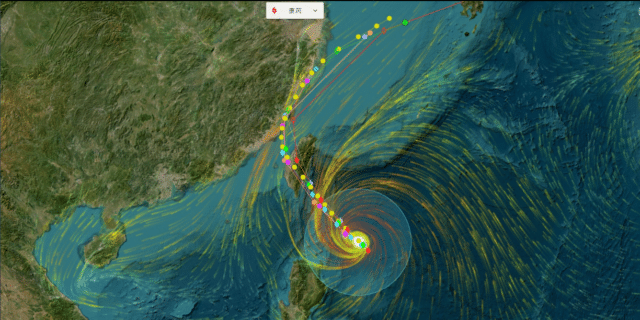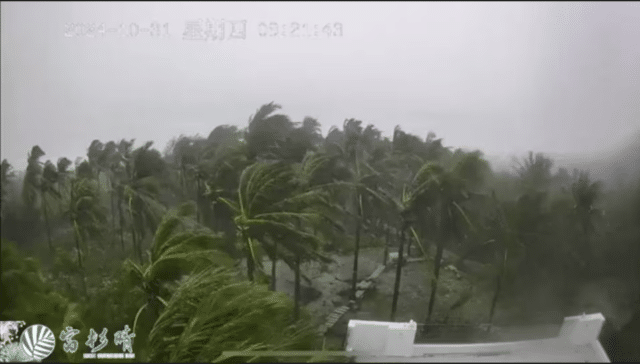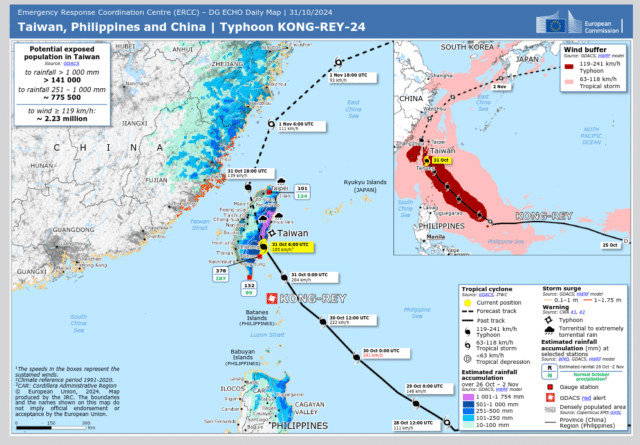Airbus A321 Landing Attempt in Typhoon
Yesterday, the 31st of October 2024, a Starlux Airlines flight bounced on the runway at Taoyuan International Airport in Taipei while attempting to land during the most severe typhoon that Taiwan has seen in thirty years.

Typhoons are not uncommon in Taiwan, with a typhoon season spanning June to October. However, Typhoon Kong-rey arrived surprisingly late in the season, bringing stronger winds than anticipated. On Tuesday, the Central Weather Administration issued a sea warning and warned that a land warning might follow. At the time, the storm was 670 kilometres southeast of Cape Eluanbi, Taiwan’s southernmost tip, and travelling towards the island at 12-16km per hour, with winds of 162 km/h (100mph, 87 knots)and gusts up to 198 km/h (123 mph, 107 knots)
By Thursday morning, the storm was moving at 20-24 km/h and the Central Weather Administration updated with a land warning for all of Taiwan. A “Typhoon Day” was declared with schools and businesses closing. Typhoon Kong-rey made landfall in Taitung County on Thursday at 13:40 local time. The Central Weather Administration reported winds at 173 km/h (107 mph, 93 knots) gusting up to 209 km/h (130 mph, 112 knots).

Taoyuan International Airport, formerly known as Chiang Kai-shek International Airport, has two parallel runways. Reports differ as to whether the aircraft was on runway 05 left or right, but either way, the asphalt runway is about 3,600 metres (12,000 feet).
Starlux flight JX871 was a scheduled passenger flight from Okinawa to Taipei in an Airbus A-321.
This is the normal ASDB data on RadarBox for today’s flight, which landed safely:
And this is the video of the aircraft trying to land yesterday in the storm, with the METAR showing 44 knots gusting 58, (although one report said the airport weather station had recorded wind up to 83 knots).
The aircraft appears on the right of the frame, crabbing into the wind.
The first approach was at 17:34 local time. In the video, the Airbus A321 suffers a bad bounce and the left wingtip seems to strike the runway before the flight crew manage to get airborne again. The second approach, about half an hour later, was successful.
A passenger video posted by 鍾維徳 (@jomg0413) on Instagram shows the cabin in darkness, bouncing and rocking. The caption says: Typhoon Kong-rey – Thrilling landing 🛬 We landed like ‘meat falling’ 🥩
According to The Star, 138 incoming flights and 129 outbound flights were cancelled, with twenty-eight inbound flights bound diverted, mostly to Hong Kong. A passenger on one of these flights said that they circled seven or eight times before diverting and landing safely in Hong Kong. Another said that the aircraft attempted three landings before diverting.
Western Pacific typhoons are named from a list of names contributed by 14 nations in the region. Kong-rey, the name of a girl from a Khmer legend, was contributed to by Cambodia.
The Hualien County Fire Department posted photographs to their Facebook page showing the damage and this video showing the flooding.
Today, the live video feeds from the airport seem to show normal operations again; however the airport arrival and departure boards are still covered with red delays and cancellations.










AVHerald reported on it:
So, a good landing, but not a great one (the distiction being that you can still use the aircraft afterwards).
A commenter remarks, “All things considered, getting away with nothing more than a scraped wing tip, and a bunch of people who may never want to fly again, was a good outcome.”
That’s too damn cowboy for my tastes.
I’d ask just what the hell were they thinking? and why didn’t they divert?
Did they not understand the destination airport would be fouled? It’s not like typhoons/hurricanes wander aimlessly and the path wasn’t known at least during pre-takeoff flight planning.
Is this just a lower level of professionalism than I’m used to?
Interesting that You Tube gave the location as Taiwan, China!
Hardly surprising that YouTube is sucking up to the PRC.
It doesn’t say PRC, though.
China is a divided country, like Korea, and like Germany used to be. Or Ukraine.
Good comments.
With the wingtip “hitting the deck” the crew had no option but to go around. But there was another grave danger: I doubt that the crew had any possibility to assess the damage. Like: was the damage structural, was the controllability of the aircraft compromised? Was the port engine damaged? There might even have been a fuel leak, the crew could not know.
Under the weather conditions of a typhoon, I can imagine that there might have been violent gusts of wind. The runway was long, a factor that may have been helpful. But what was the crosswind component?
Long lenses always distort the images. Videos of crosswind landings taken with a tele lens always look far more dramatic than the reality.
But the first landing looked very dramatic just the same. But even taking into account what will follow, another admission of sins, I might have diverted. A typhoon is a very violent and insofar as its effect on aviation is concerned unpredictable weather phenomenon.
The video is a clear example of why aircraft with tail-mounted engines have a great advantage. And so do high-wing aircraft (most of them propeller-driven).
Because aircraft with underslung engines must be landed from a crab. The crew kicks the rudder to straighten the aircraft, but the ailerons are nearly kept neutral. The aircraft must touch down wings level, or an engine or wing tip may hit the runway.
The video shows clearly that a very strong gust hit the aircraft just as it was landing. Which blew the ‘plane over on its left wing.
With tail mounted, or high wing mounted engines the pilots can control the aircraft right until it sets down in what is essentially a sideslip . The upwind wing can be held low right until the very last moment, and after landing ailerons can be held “into the wind”. Which greatly reduces the possibility that the wind will blow the aircraft on its downwind wing. That clearly happened in this incident.
Using this technique I have even landed a Citation 550 and even a Shorts 3-60 in a wind with a crosswind factor of about 40 kts. It was a night cargo flight, no passengers were on board.
I tried it successfully in a BAC 1-11 but the training captain was not impressed.
The biggest struggle with the Shorts was that both my FO and I had to hold the ailerons into the wind with all our combined strength until we had slowed down enough to engage the gust lock. OK, I have owned up. We should have diverted. No other plane landed at Dublin that night.
We had trained for extreme crosswind operations in the Citation in a simulator, supervised by an FAA inspector. The simulator had a short, critical runway in its database and we practised this with engine failures in increasing crosswind. I lost control on take-off with an engine failure at V! with a crosswind component of 43 kts. My colleague managed, but I managed to land it and he did not.
We were actually cleared to operate under strong crosswind conditions. The manual gave 24 kts, “demonstrated”. This was not a limit, so we demonstrated that we could manage much stronger crosswinds. The FAA inspector accepted this and we were given individual authorisation to land with a crosswind component of more than 40 kts.
The Shorts 3-60, also known as the Flying Portacabin, The Shed, or worse: The Vomit Comet (it was not pressurised so we were always confined to the turbulence in the lower airspace) had a limit of 29 kts.
The Fokker F27 and 50 had a very large tail fin. This meant that in a very strong crosswind the “weather cocking” tendency was virtually impossible to overcome. The limit was 29 kts and that was it.
I never exceeded that in the Fokkers, and don’t think that I could have managed.
My experience level was in the multiple thousands of hours. Even so, looking back, I was entering the category of “Bold but not yet so Old” pilot. Showing off can be very dangerous. And has killed many.
I was not one of them.
I guess that I had “Mother Luck”, aka my Guardian Angel on my side.
I just like the idea of “V!” :)
A Chinese-speaking reader has sent me this news report and said that the pilot has been suspended: https://www.youtube.com/watch?v=M37f0SArmjs
I am not surprised, Sylvia.
If I had effed up when landing the Sorts 360 in an extreme crosswind there is no doubt that I would have been fired on the spot.
What happened: The return leg of a cargo flight from Coventry.
It was night. There was work in progress on the main runway, 28. This was closed during night time to facilitate the work. The met office had forecast a very strong westerly wind the night before. So runway 28 was kept open, the work halted. Which was expensive as the contractors would still be paid. But there was barely any wind at all. So when the same weather, and gale force wind from the west was forecast the following night the airport authorities ignored it and runway 28 was closed. But this time the wind materialised, with a vengeance Wind gusts up to 45 kts from the west, and the only runway open was to the south. All traffic either cancelled outright, or diverted. Only a little Shorts 360 on a cargo flight from Coventry (me) landed. Far over the crosswind limits.
ATC does not initiate reports if there is nothing to report.
After all, the captain is responsible.
So “nothing to report” means: the aircraft landed without incident, as cleared, no damage, stayed on the runway centreline, then taxied to the ramp and shut down. Crew finished their duties.
Aircraft’s wind limitations are not ATC’s concern.
So nobody was informed. The controllers probably raised an eyebrow or two. But the company Chief Pilot never heard anything about it, certainly not officially.
I got away with it.
Did I the right thing?
To the client, Target (they don’t exist any more), absolutely. I saved them a lot of headache. They chartered the flight, so they were not involved otherwise.
But if my co-pilot had not helped holding the ailerons into the wind, we probably would have been blown onto the left wingtip.
I had briefed him, yes, but we met years later at an aviation medical. He told me that he had not really expected me to actually land.
Good airmanship?
No, definitely not !
AVHerald has more information today. The airline sent a message and a photo of the left wingtip.
So, a great landing.
AVHerald quotes the METAR with a wind of 08044G58KT , and the runway was 05R, so the expected crosswind would be 22 kt gusting 29kt.